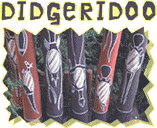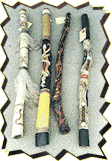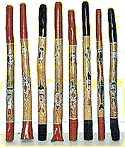 |
 |
 |
|
|||

Didgeridoo: Sound of Australia
Tourists gather on the steps of the Sydney Opera House. They gaze at the blue of Sydney Harbor, the yellow ferries and the sparkling white tiles on the wave-shaped roof of Australia's best known modern building. Meanwhile, the tourists are entertained by a street musician. Japanese schoolchildren, in neat uniforms, listen politely. The song is "Waltzing Matilda." The bagpipes, which are playing it today, are not exactly what come to mind when we think of Australian music. This is more appropriate.
A crowd has gathered around owner Gavin Rose playing the tubular instrument which is almost as tall as he is. But his name for it is not how it's come to be known.
There's a sign in English and Japanese which explains that the yedaki is meant for a spiritual purpose. It's strictly a men's ceremonial instrument and women customers are asked not to pick them up. 
Most of the instruments sell for just over $100. They are, in fact, naturally hollowed out tree trunks. Ever resourceful, Aboriginals put damaged trees to creative use.
The music of the yedaki tells stories and mimics animals. This is the laughing kookaburra bird calling in the bush. In the Aboriginal's totemic belief system, every animal and plant has an important spiritual place. Each has a role and each deserves respect. In Sydney, Australia, this is Judith Kampfner for the Savvy Traveler. Didgeridoo and Aboriginal Links
|
 | American Public Media Home | Search | How to Listen ©2004 American Public Media | Terms of Use | Privacy Policy |
 The Australian Aboriginal instrument, the didgeridoo, is now used in
many bands across the world. In a shopping mall on Sydney Harbor is a
gallery owned by Alana Rose and her partner Gavin. They are Aboriginals
with great pride in their heritage, which they consider to be the oldest
living culture in the world.
The Australian Aboriginal instrument, the didgeridoo, is now used in
many bands across the world. In a shopping mall on Sydney Harbor is a
gallery owned by Alana Rose and her partner Gavin. They are Aboriginals
with great pride in their heritage, which they consider to be the oldest
living culture in the world.